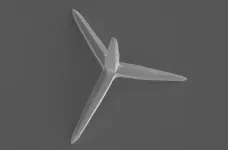(Press-News.org) In ancient Greece, over 3000 years ago, wise men used silver salts to prevent wounds from becoming infected. These salts continued to be used until Alexander Fleming discovered the first antibiotic "just" 100 years ago. The use of antibiotics represented a major breakthrough in the treatment of infectious diseases, but resistance soon began to emerge. Bacteria, which have been on the planet longer than us, have found ways to overcome different antibiotics, and today antibiotic resistance is a major global health problem.
In times when everything evolves very quickly, it is interesting to gain perspective, to return a bit to the origins. That is why attention has turned back to silver salts, which had so much use years ago and in fact never stopped being used. Silver salts are the basis of microscopic crystals or micromotors constructed by researchers from the Institute of Chemical Research of Catalonia (ICIQ-CERCA) in Tarragona, in collaboration with the Catalan Institute of Nanoscience and Nanotechnology (ICN2). These crystals move autonomously (hence the name micromotors) in aqueous media under visible light irradiation. On their journey, they inactivate present bacteria, becoming a promising tool for environmental recovery.
The group led by Dr. Katherine Villa at ICIQ, in collaboration with ICN2, has published a study in the journal Advanced Optical Materials presenting a simple technique for producing microscopic crystals that activate in the presence of light. Activation involves autonomous movement and the release of silver ions and free radicals with antimicrobial activity, self-degrading, and thus leaving the water free of the crystals themselves.
As Dr. Villa explains, "this work is important because we report a synergistic effect that includes the self-propulsion capability of the micromotors under light stimuli, allowing greater diffusion and dispersion of silver ions as well as released free radicals."
The researchers easily develop microscopic structures containing silver phosphate and shaped like tetrapods. We are not talking about four-legged animals, but a crystalline structure formed by 4 arms, each about 5 micrometers long. These crystals, called TAMs move autonomously through photocatalysis.
We talk about photocatalysis when light acts as a catalyst, in this case, causing the silver phosphate of the TAMs to react with the water in the medium, releasing oxygen, silver ions, and free radicals. The compounds generated from the reaction are responsible for moving the TAMs, and moreover, the released radicals and silver ions kill the bacteria present in the medium. This bactericidal action is explained by the effect of silver on the bacterial walls, affecting their permeability and thus causing irreparable damage to the cell wall, leading the bacteria to death.
The silver ions released from these micromotors become silver nanoparticles that can be easily recovered by filtration, avoiding additional contamination. As Dr. Villa explains, "the micromotors are twice as efficient compared to silver nanoparticles alone, according to the results obtained in the study. Additionally, if we prevent their movement, the antibacterial capacity of these micromotors is drastically reduced."
Micromotors are a very interesting tool for environmental recovery. Last year, Dr. Villa's team developed micromotors coated with laccase, a chemical compound that accelerates the conversion of urea into ammonia. Urea is an emerging contaminant, as it is a common product of residential activities (urea is the main component of urine) and various industrial processes, while ammonia is gaining importance as a green energy source; this compound can be decomposed for hydrogen production and can be stored as green fuel.
About Institute of Chemical Research of Catalonia (ICIQ-CERCA)
The Institute of Chemical Research of Catalonia stands as a forefront research centre dedicated to advancing scientific knowledge, with a commitment to addressing social and economic challenges, such as climate change, sustainable raw material supply and energy sources.
Distinguished with two Severo Ochoa excellence accreditations, ICIQ is globally recognized as a benchmark in cutting-edge chemical research. Our Institute comprises 316 researchers, organized into 18 research groups that specialize in sustainable catalysis, renewable energies, and health. Excellence is propelled through the seamless integration of computational and experimental research methodologies.
ICIQ researchers have achieved significant success, securing 25 projects funded by the European Research Council (ERC Grants). Additionally, 8 of our researchers hold ICREA professorships, solidifying ICIQ’s position as a premier centre attracting international talent.
Situated in Tarragona, at the heart of Southern Europe’s major petrochemical complex, ICIQ actively collaborates with the industry, facilitating the transfer of knowledge and driving the development of innovative applications, with a distinct emphasis on patents and spin-offs. A cornerstone of our mission is the training of the next generation of scientists through high-level education programmes.
As a CERCA centre and member of BIST, ICIQ is committed to shaping the future of chemical research as a driving force for contributing to a sustainable and equitable development. For further information, please visit www.iciq.es © 2024. All rights reserved.
END
Significantly reducing trans fat levels in the Nigerian food supply could prevent approximately 10,000 heart disease deaths and save 90 million USD (12 billion Naira, ₦) in healthcare costs over a decade. New findings by The George Institute for Global Health on the health and economic benefits of enacting the country’s trans fat elimination policy were published today in BMJ Global Health.
In 2023, Nigeria followed South Africa as only the second African country to adopt a best practice trans fat ...
A new paper in JNCI Cancer Spectrum, published by Oxford University Press, finds that following a healthy diet lowers the risk of cardiovascular disease in breast cancer survivors.
Cardiovascular disease is the top non-breast cancer related cause of death in women with breast cancer. There are more than 3.8 million female breast cancer survivors in the United States. These women are at higher risk for cardiovascular disease than women who have not had breast cancer. This is likely due to the cardiotoxic effects of breast cancer treatment, as well as common risk factors for both breast cancer and cardiovascular disease, such as aging, lack of exercise, ...
Perovskites are among the most extensively studied materials in modern materials science. Their often unique and exotic properties, which stem from perovskite’s peculiar crystal structure, could find revolutionary applications in various cutting-edge fields. One intriguing way of realizing such properties is through the precise ordering of a perovskite’s defects, such as vacancies or substitutions.
In oxide chemistry, scientists have known for a long time that oxide defects can spontaneously and consistently arrange themselves throughout the crystal lattice, once they reach certain concentrations (e.g. integer ratio). This emerging ...
Artificial intelligence (AI) could be a vital tool to promote peace, prevent violent conflict, and safeguard human rights – if used responsibly, experts say.
Much focus has been on AI’s potential for catastrophic harm from powering drone swarms for international warfare to generating deep fakes which spread misinformation and prejudice.
But authors Branka Panic and Dr Paige Arthur say AI-driven technology should also be seen as a potential force for good in conflict-torn countries to ‘wage peace’.
With the ongoing wars in Ukraine and Gaza and three decades on from the Rwandan genocide, their book AI for Peace highlights concrete ways that AI tools are being used to ...
Volunteer clean-ups have resulted in almost nine tonnes of marine litter being cleared from beaches across the Seychelles, in what researchers have described as a powerful demonstration of the potential of citizen science.
More than 1,220 volunteers were recruited to clear 52 beaches on ten islands at various points between June 2019 and the end of July 2023. In that time, they surveyed around 930,000m2 of beaches, with volunteers picking up items ranging from foam and rubber to metals and plastics.
In total, the ...
The world's first dual-beamline photoelectron momentum microscope has been developed at the UVSOR Synchrotron Facility, Japan. This innovative experimental station brings breakthroughs in studying the behavior of electrons in materials governing material properties, particularly in analyzing valence orbitals.
Understanding the behavior of electrons in materials is crucial for the advancement of materials science and device engineering. Conventional photoelectron spectroscopy provides deep insight into the nature of the electronic structure of solids. Currently, the challenge of researching electronic structures on the micrometer scale is being pursued all over the world. ...
A research team consisting of Professor Kyoung-Duck Park and Taeyoung Moon and Huitae Joo, PhD candidates, from the Department of Physics at Pohang University of Science and Technology (POSTECH) has engineered “broadband nanogap gold spectroscopic sensor” using a flexible material capable of bending to create a controlled gap. With the developed technology, it is possible to rapidly test various types of materials, including infectious disease viruses, using only a single nano-spectroscopic ...
New research shows that ethnic minorities are underrepresented in studies into multiple long-term conditions (MLTCs), despite being more likely to be affected.
A systematic review published in the Journal of the Royal Society of Medicine found a lack of reporting on ethnicity and underrepresentation of ethnic minority groups in intervention studies to improve the management of MLTCs.
The prevalence of MLTCs is escalating, due to ageing populations and lifestyle shifts. In England, an estimated one in four adults have two or more long-term health conditions, impacting quality of life and healthcare costs. Ethnic minorities, previous research says, face an increased burden due ...
A new study shows that ocean acidification is changing the mix of microbes in coral reef systems, which can be used to assess ecosystem health.
The study, published today in Microbiome, looked at coral reefs specifically, but the researchers say it could be widely applicable as a method for measuring how ecosystems are responding to human activities.
Understanding how ecosystems are changing in response to human activity allows predictions of their future, and how to conserve them. Although microbes are crucial for ecosystems – supporting critical functions such as nutrition and immune system modulation – changes ...
Spending too much time online to the point of compulsion and the neglect of other necessary activities, plus not sleeping or exercising enough, are linked to a heightened risk of both truancy and school absence due to illness among teens, finds research published online in the Archives of Disease in Childhood.
Teenage girls seem to be more vulnerable than teenage boys to excessive internet use, but getting the recommended quota of shut eye and exercise and having a trusting relationship with parents all seem to be protective, the findings indicate.
Although differences in how excessive internet use is assessed and categorised can make it difficult to quantify, digital media ...







